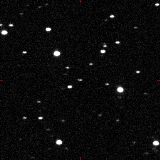
2004 FH
Encyclopedia

Lincoln Near-Earth Asteroid Research
The Lincoln Near-Earth Asteroid Research project is a cooperative project between the United States Air Force, NASA, and MIT's Lincoln Laboratory for the systematic discovery and tracking of near-Earth asteroids. LINEAR was responsible for the majority of asteroid detections since 1998 until...
. The object is roughly 30 metres in diameter and passed just 43000 km (26,719 mi) above the Earth
Earth
Earth is the third planet from the Sun, and the densest and fifth-largest of the eight planets in the Solar System. It is also the largest of the Solar System's four terrestrial planets...
's surface on March 18, 2004, at 22:08 UTC
Coordinated Universal Time
Coordinated Universal Time is the primary time standard by which the world regulates clocks and time. It is one of several closely related successors to Greenwich Mean Time. Computer servers, online services and other entities that rely on having a universally accepted time use UTC for that purpose...
; making it the 11th closest approach to Earth recorded (see the diagram below). For comparison, geostationary satellites orbit Earth at 35,790 km.
2004 FH is an Aten family asteroid
Aten asteroid
The Aten asteroids are a group of near-Earth asteroids, named after the first of the group to be discovered . They are defined by having semi-major axes of less than one astronomical unit...
, although by some definitions it should be called a meteoroid
Meteoroid
A meteoroid is a sand- to boulder-sized particle of debris in the Solar System. The visible path of a meteoroid that enters Earth's atmosphere is called a meteor, or colloquially a shooting star or falling star. If a meteoroid reaches the ground and survives impact, then it is called a meteorite...
, since it is smaller than 50 metres in diameter. Despite its relatively small size (about 30 metres), it is still the fourth largest asteroid detected coming closer to the Earth than the Moon.
Had this object hit Earth, it would probably have detonated high in the atmosphere
Earth's atmosphere
The atmosphere of Earth is a layer of gases surrounding the planet Earth that is retained by Earth's gravity. The atmosphere protects life on Earth by absorbing ultraviolet solar radiation, warming the surface through heat retention , and reducing temperature extremes between day and night...
. It might have produced a blast measured in hundreds of kilotons of TNT, but may not have produced any ground level effect. It could also have been an Earth-grazing fireball
Earth-grazing fireball
An Earth-grazing fireball is a small solar system body that enters the Earth's atmosphere and leaves again. If it starts to break up in the atmosphere it can become an Earth-grazing meteor procession, and some fragments may impact the Earth...
if it had been much closer but not close enough to impact.
The asteroid will not make another close approach to Earth until 2044 when it will be no closer than 1.4 Gm (1.4 million kilometres). 2004 FH also has the distinction of having the lowest inclination
Inclination
Inclination in general is the angle between a reference plane and another plane or axis of direction.-Orbits:The inclination is one of the six orbital parameters describing the shape and orientation of a celestial orbit...
of any known near-earth asteroids.
Two weeks later another asteroid approached even closer, , which was smaller, and a few years later , which was closer in size passed by at similar distance.


